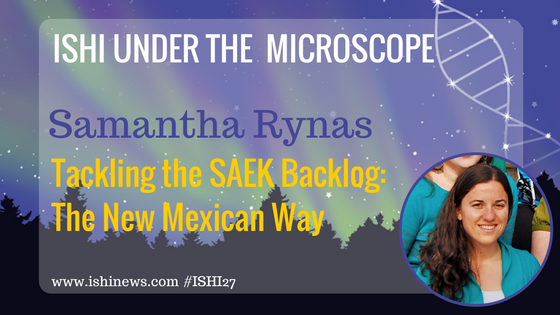The ISHI27 agenda is already filling up with some great talks from amazing speakers! While the forensic community is a tight-knit group, we can always get a little closer, right? With that in mind, we asked our speakers some questions to get to know them a little better outside of their work. We’ve been posting their responses in a feature we like to call Under the Microscope.
Today, we’re chatting with Rachel Oefelein, who will be presenting Tackling the SAEK Backlog: The New Mexican Wayduring the General Sessions on Wednesday, September 28th.
Samantha Rynas is a Forensic Scientist in the Serology/DNA Section at the New Mexico Department of Public Safety, where she has worked for the past 4 years. She received her Bachelors in Biology from Pfeiffer University, North Carolina, and her Masters in Forensic Science from The George Washington University, Washington DC. When she is not working, she is either drawing cartoons for a science education book as part of the Inner City Science program based out of Denver CO, speaking with various students about careers in STEM fields, or crashing Promega welcome receptions in full cycling spandex – sweat and all.
How did you come to work in the field of forensics/DNA?
Started in undergrad doing a research project on a “Twinning Gene”, which I had a personal interest in since I am an identical twin. From there I looked into DNA focused fields and found Forensic DNA testing, and from there the rest is history.
What is the biggest challenge you face in your job?
There is a constant push to get more cases out and reduce the backlog; we are being pushed to work more and work faster. There is that fine line between getting quality work out while work as efficiently as possible.
If you’ve attended ISHI before, what keeps you coming back? If you’ve never attended before, what are you most looking forward to at ISHI27?
I enjoy the atmosphere and hearing about not only other labs but other countries and how they are growing and learning.
When you were little, what career did you think you’d have as an adult?
I always played with microscopes as a kid and really enjoyed all science, so something in science but wasn’t sure what. I once thought of doing the drawings of all the cells/structures in science books.
Where do you see the future of forensic science headed?
With the increase in sensitivity and detection I think there is a big question and has already been research on how much transfer (secondary etc…) could potentially be affecting our results, or more specifically how investigators interpret those results. I think this will be a continued focus on learning what can be said about minimal amounts of DNA and how they came to be where they are.
What do you hope the audience learns/takes away from your talk?
I hope my talk can help give a direction for other labs for their backlog. Whether it’s adopting a y-screen type method or pushing the value in these kits to their legislature to get the funding they need to work these cases.
What person would you say has had the biggest influence in your career?
I would say my previous co-worker Annette. She’s a great teacher and makes everything look easy.
Star Wars or Star Trek?
Neither. Anything Gene Wilder/Mel Brooks.
WOULD YOU LIKE TO SEE MORE ARTICLES LIKE THIS? SUBSCRIBE TO THE ISHI BLOG BELOW!


